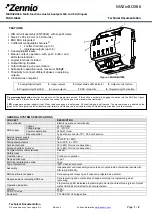Chapter 1 MC9S12C and MC9S12GC Device Overview (MC9S12C128)
Freescale Semiconductor
MC9S12C-Family / MC9S12GC-Family
59
Rev 01.24
The security byte resides in a portion of the Flash array.
Check the Flash Block User Guide for more details on the security configuration.
1.5.2.2
Operation of the Secured Microcontroller
1.5.2.2.1
Normal Single Chip Mode
This will be the most common usage of the secured part. Everything will appear the same as if the part was
not secured with the exception of BDM operation. The BDM operation will be blocked.
1.5.2.2.2
Executing from External Memory
The user may wish to execute from external space with a secured microcontroller. This is accomplished
by resetting directly into expanded mode. The internal FLASH will be disabled. BDM operations will be
blocked.
1.5.2.3
Unsecuring the Microcontroller
In order to unsecure the microcontroller, the internal FLASH must be erased. This can be done through an
external program in expanded mode or via a sequence of BDM commands. Unsecuring is also possible via
the Backdoor Key Access. Refer to Flash Block Guide for details.
Once the user has erased the FLASH, the part can be reset into special single chip mode. This invokes a
program that verifies the erasure of the internal FLASH. Once this program completes, the user can erase
and program the FLASH security bits to the unsecured state. This is generally done through the BDM, but
the user could also change to expanded mode (by writing the mode bits through the BDM) and jumping to
an external program (again through BDM commands). Note that if the part goes through a reset before the
security bits are reprogrammed to the unsecure state, the part will be secured again.
1.5.3
Low-Power Modes
The microcontroller features three main low power modes. Consult the respective Block User Guide for
information on the module behavior in stop, pseudo stop, and wait mode. An important source of
information about the clock system is the Clock and Reset Generator User Guide (CRG).
1.5.3.1
Stop
Executing the CPU STOP instruction stops all clocks and the oscillator thus putting the chip in fully static
mode. Wake up from this mode can be done via reset or external interrupts.
1.5.3.2
Pseudo Stop
This mode is entered by executing the CPU STOP instruction. In this mode the oscillator is still running
and the real time interrupt (RTI) or watchdog (COP) sub module can stay active. Other peripherals are
turned off. This mode consumes more current than the full stop mode, but the wake up time from this mode
is significantly shorter.
Summary of Contents for MC9S12C Family
Page 689: ......


















